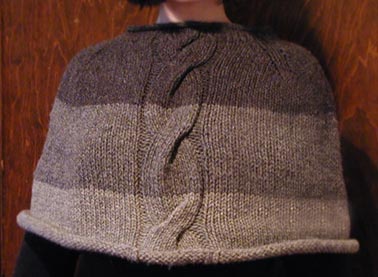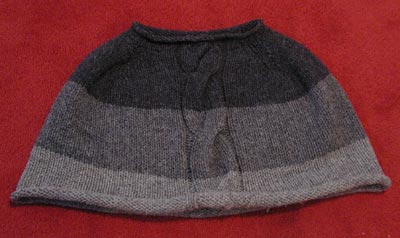
Time: 8 hours?
Cost: $12
Skills: Knitting in the round on circulars, cables
Level: Beginner
I just love my little capelet (is this actually a capelet? I’m not 100% on the terminology, but it seems too little to call a poncho…). It’s toasty, but light and short enough (elbow-length) to throw over anything and still have a pretty normal range of motion. If you don’t like the rolled edges, trim in garter or seed or something unrolly, or start with a couple knit rows and a purled row & turn the edge under to hem.
It’s knit in the round from the bottom up, and there’s a simple, fat cable going up the middle. It’s a good, easy project for My First Cable. And this was, in fact, my first cable that wasn’t just a swatch. I kind of only like big fat cables.
This yarn is cheap (under $4 for a 4oz hank) and old timey and I love it. It’s called Briggs & Little, from Canada’s oldest yarn mill, apparently. It’s got lots of lanolin & feels stiff to begin, but kind of warms up as you knit it. With washing, it blooms from a somewhat stiff fabric to something soft and full and bouncy. It’s a little rough for a next-to-skin item, but it’s fantastic and sturdy for something layered, like this capelet.
This garment uses 3 natural-looking colored heathered grays. There’s a fair amount of vegetable matter you have to pick out, but I actually kind of like that, makes it feel all the more rustic.
You can mail order it from Deanna Dunsmuir in New Brunswick.
Size
Women’s One size (SML).
Note: For larger sizes, use an extra hank or two (for instance, start with a hank of Sheep’s Gray, lighter, or Threaded White & Gray, a twist; or end with a hank of Black) and adjust pattern based on washed & blocked gauge. (If that’s too vague, email me & I’ll quit being so lazy and figure out the math.)
Yarn
- 1 hank (4 oz) each color Briggs & Little Atlantic (100% wool) in Dark Gray, Medium Gray, and Light Gray
Needles
- US 10.5 24-30″ and 16″ circular needles
- Close size dpn in wood or bamboo (or you can use a cable needle or the extra circular)
Gauge
- 11.5 st=4″ washed & blocked
Patterns
Cable 12 back: Slip next 6 st onto cable/extra needle. Move those stitches to the back of your work, then knit the next 6 stitches on your left needle. Side the reserved stitches to the end of the needle they’re on, and knit them onto your right needle.
Cable 6 back: Slip next 3 st onto cable/extra needle. Move those stitches to the back of your work, then knit the next 3 stitches on your left needle. Side the reserved stitches to the end of the needle they’re on, and knit them onto your right needle.
Instructions
Light Gray
- With Light Gray, CO 145. Join & PM, being careful not to twist st.
- Place cable panel markers: K64, P2, PM, K12, PM, P2, K to end.
- Work 13 more rnds in pattern
- K 64, P2, SM, Cable 12 back, SM, P2, K to end
- Work 8 more rnds in pattern
Switch to Medium Gray. Starting with #3, work as for Light Gray.
Switch to Dark Gray.
Note: You’ll need to switch to the smaller needles after a few decrease rows–after the cable is a convenient point.
- Work 9 rows in pattern.
- PM for raglan shoulder decreases: K24, PM, K24, PM, K16, P2, SM, K12, SM, P2, K16, PM K24, PM, K to end.
- Decrease before and after each shoulder marker (not cable markers or row end marker!) every other rnd, three times–121 st
- Work rnd in pattern, working Cable 12 back at center panel.
- Decrease before and after each shoulder marker (not cable markers or row end marker!) every other rnd, two more times–105 st
- Work 1 rnd plain
- Decrease before and after each shoulder marker (not cable markers or row end marker!) every rnd, three times–81st
- Decrease one last time before and after each shoulder marker, and also work the following decrease/cable between the cable markers: ssk, K1, Cable 6 back, K1, K2tog.
- Work row plain, except between cable markers: ssk, K4, K2tog.
BO. Weave in all ends, working in ends at color joins in duplicate for a few stitches, then weaving in normall.
Soak in cool water with wool wash or shampoo for 5 minutes. Squeeze suds through gently, rinse gently, roll in towels, pat into place, and let air dry.
Here’s a crappy picture of me wearing the capelet, which is a little rumpled from being worn nonstop for a week & then wadded up on a chair for another week. It’s I’m useless with the auto-timer, so I’ll try to get Ron to take a fresh, pretty shot next time I get around to washing it.


I love it!
Dood, I love your mascot, too. The whole blog is awesome!
Thanks! I’m finally getting to satisfy my desire to chronicle the excruciatingly dull details of my craft life without sending poor Ron into a coma. Haven’t really mastered using the software yet, though.
Can I ask you a question about this gorgeous pattern? For instructions regarding the decrease rounds: do I decrease the round and then knit a round in the pattern in between, then decrease, knit the pattern, then decrease again? Or do I just do three rounds of decreasing the pattern? Also, in instruction #8, do you mean to cable 6 back (slip 3 stitches and move to back of work then knit 3, then knit slipped stitches)? Sorry to bother you, I think the piece is so lovely and I’m almost done. Just want to make sure I do it right! Kind regards, D
On #7, no plain rnds in between (or, honestly, you could & it wouldn’t matter–I wrote this so long ago, I can’t remember why the more rapid decrease at the end). And from looking at the pattern notes, which mention c6b not c3b, I think that must be a typo, which I am going to fix right now!